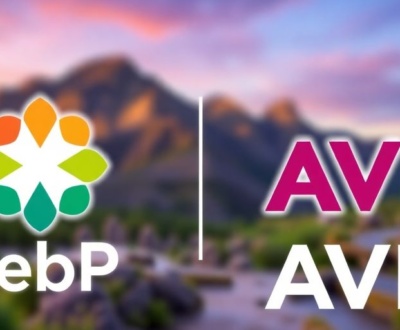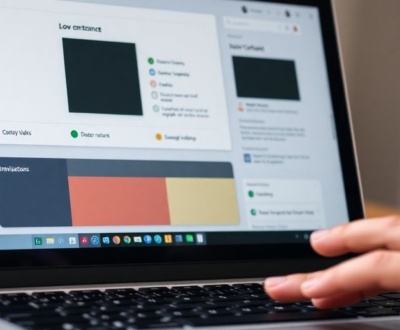Have you ever been on a website and noticed how smooth everything feels, especially when new images or content just pop into view as you scroll? A lot of times, that’s thanks to something called the Intersection Observer API. This neat little tool helps developers make websites run super well by keeping an eye on when stuff on the page actually becomes visible to you. It’s a game-changer for performance, and in this article, we’re going to check out how the Intersection Observer API makes web design faster and better for everyone.
Key Takeaways
- The Intersection Observer API lets you watch for when parts of your webpage come into view, which is way more efficient than older methods.
- Using this API can make your website run faster, use less of your computer’s power, and generally feel smoother to use.
- It’s great for things like loading images only when you can see them, creating endless scrolling pages, or checking if ads are actually being viewed.
- Setting it up isn’t too hard: you just make an observer, tell it what to look for, and then attach it to the elements you care about.
- The Intersection Observer API helps avoid slowing down your website, and it’s built to be efficient, unlike some other ways of tracking visibility.
Understanding the Intersection Observer API
Defining the Intersection Observer API
Okay, so the Intersection Observer API? It’s this thing that lets you watch HTML elements and see when they pop into or out of the browser’s visible area. Basically, it’s like having a little scout that tells you when an element intersects with the viewport (or another element you specify).
Think of it this way:
- You’ve got a target element (the thing you’re watching).
- You’ve got a root element (the thing the target is intersecting with, like the viewport).
- The API tells you when and how much the target and root intersect.
It’s super useful because it lets the browser handle the heavy lifting of figuring out when elements are visible, instead of you having to write a bunch of complicated code that slows everything down.
Asynchronous Observation for Performance
One of the coolest things about the Intersection Observer API is that it’s asynchronous. What does that mean? Well, it doesn’t sit there constantly checking if elements are visible. Instead, it waits for the browser to tell it when something changes. This is a big deal because it means:
- Less work for the main thread (the thing that makes your website run).
- Smoother scrolling and animations.
- Better overall performance.
The Intersection Observer API is designed to be efficient. It avoids constantly checking element positions, which can be resource-intensive. Instead, it relies on the browser to provide updates only when necessary, leading to significant performance improvements.
Core Functionality and Mechanism
So, how does this thing actually work? The Intersection Observer API revolves around a few key concepts:
- Creating an Observer: You make a new
IntersectionObserverobject and give it a callback function. This function is what gets called when an intersection happens. - Setting Options: You can tell the observer how to watch for intersections. For example, you can specify a root element (like the viewport) and a threshold (how much of the element needs to be visible before the callback is triggered).
- Observing Elements: You tell the observer which elements to watch. It then monitors those elements and calls your callback function whenever they intersect with the root element according to your specified options.
The intersection ratio is a key piece of information you get in the callback. It’s a number between 0.0 and 1.0 that tells you what percentage of the target element is visible. 1.0 means the whole element is visible, 0.0 means none of it is.
Key Benefits of the Intersection Observer API
The Intersection Observer API brings a lot to the table when it comes to web performance and user experience. It’s not just about making things look better; it’s about making them work better, too. Let’s break down some of the key advantages.
Enhanced Performance Over Traditional Methods
The Intersection Observer API offers a more efficient way to detect element visibility compared to traditional methods like scroll event listeners. Instead of constantly checking the position of elements on every scroll event, the Intersection Observer passively monitors elements and triggers a callback only when they enter or exit the viewport. This approach reduces the amount of work the browser has to do, leading to smoother scrolling and faster page load times. Think of it as having a security guard who only reports when something actually happens, rather than constantly patrolling and reporting every step.
Reduced CPU Usage and Improved Frame Rates
One of the biggest wins with the Intersection Observer API is the reduction in CPU usage. Because it avoids the constant polling associated with scroll event listeners, it frees up the CPU to handle other tasks. This translates directly into improved frame rates, especially on complex pages with lots of animations or dynamic content. A smoother experience is always a plus, and this API helps achieve that goal.
Optimized Resource Management
With the Intersection Observer API, you can optimize how your website loads resources. For example, you can implement lazy loading for images and other content, only loading them when they are about to become visible. This reduces the initial page load time and saves bandwidth, especially for users on mobile devices or with slow internet connections. It’s like only buying groceries when you’re about to cook dinner, rather than stocking up on everything at once and letting some of it go bad. Here’s a quick look at the impact:
- Reduced initial page load time
- Lower bandwidth consumption
- Improved user experience on slow connections
Using the Intersection Observer API can significantly improve your website’s performance by reducing CPU usage, improving frame rates, and optimizing resource management. It’s a modern approach to handling element visibility that can make a real difference in the user experience.
Practical Applications of the Intersection Observer API

The Intersection Observer API isn’t just some fancy tech; it’s a practical tool that can seriously improve how websites perform and feel. It’s all about knowing when elements are visible, and using that knowledge to do things smarter. Let’s look at some real-world uses.
Implementing Lazy Loading for Images and Content
Lazy loading is a classic use case. Instead of loading all images and content upfront, which can slow down the initial page load, you only load them when they’re about to come into view. This can drastically reduce initial load times, especially on content-heavy pages. The Intersection Observer makes this easy. You set up an observer on each image or content block, and when it intersects with the viewport, you load the resource. It’s way more efficient than using scroll events, which fire constantly and can bog down the main thread. Think of it as only preparing the meal when the guest is at the table, not hours in advance.
Creating Infinite Scrolling Experiences
Infinite scrolling is everywhere these days. Instead of paginating content, you just keep scrolling, and more content loads automatically. The Intersection Observer is perfect for triggering the loading of new content. You attach an observer to a sentinel element at the bottom of the currently loaded content. When that sentinel comes into view, you fetch and append the next batch of content. This creates a smooth user experience without the performance hit of constantly checking the scroll position. It’s like having a waiter who knows exactly when to bring out the next course.
Tracking Advertisement Visibility Accurately
For advertisers, knowing whether an ad is actually seen is crucial. The Intersection Observer provides a reliable way to track ad visibility. You can configure the observer to trigger when a certain percentage of the ad is visible for a certain amount of time. This gives you much more accurate data than simply tracking whether the ad is present in the DOM. It ensures that you’re only counting impressions when the ad has a real chance of being seen. This is like knowing if someone actually ate the food, not just if it was placed in front of them.
The Intersection Observer API offers a streamlined approach to managing resource loading and user interactions based on element visibility. By focusing on actual visibility rather than relying on scroll events or timers, it minimizes unnecessary processing and contributes to a more responsive and efficient web experience.
Setting Up Your First Intersection Observer
Initializing the Observer Instance
Okay, so you’re ready to actually use the Intersection Observer API? Great! The first step is creating an instance of the observer. This involves calling the IntersectionObserver constructor. You’ll need to provide a callback function. This function is what gets executed every time a target element intersects with the root element (usually the viewport) based on the thresholds you set. Think of it as the ‘do something’ part of the whole process. The constructor also accepts an optional options object, which we’ll get into in the next section. After the observer creation, you’re ready to configure it.
Configuring Observer Options
The options object is where you define how the Intersection Observer should behave. It lets you customize how the observer calculates the intersection with the viewport. There are three main options you’ll probably use:
root: This specifies the element that serves as the viewport for the target element. If it’snull, the browser viewport is used. It’s important to note that the API works the same way whether you’re using the viewport or some other element as the root.rootMargin: This is a margin around the root. It can grow or shrink the root’s bounding box, effectively changing when the callback is triggered. You can use values like ’10px 20px 30px 40px’ (top, right, bottom, left) or just ’10px’ for all sides.threshold: This is probably the most interesting one. It’s a number or an array of numbers between 0.0 and 1.0, representing the percentage of the target element that must be visible for the callback to be triggered. A threshold of 0.0 means the callback runs as soon as even one pixel is visible, while 1.0 means the entire element must be visible.
Setting these options correctly is key to getting the Intersection Observer to work the way you want. Experiment with different values to see how they affect the timing of your callbacks.
Attaching the Observer to DOM Elements
Once you’ve created your Intersection Observer instance and configured its options, the final step is to tell it which DOM elements to watch. You do this using the observe() method. You simply pass the DOM element you want to track to this method, and the observer will start monitoring its visibility. The target element is what triggers the callback. You can observe multiple elements with the same observer instance, which is pretty efficient. Remember that the callback we set up for the observer will be executed now for the first time. It waits until we assign a target to our observer (even if the target is currently not visible).
Advanced Techniques with Intersection Observer API
Monitoring Multiple Elements Efficiently
The Intersection Observer API really shines when you need to keep tabs on a bunch of elements at once. Instead of creating a separate observer for each element, you can use a single observer to watch them all. This is way more efficient because the browser only has to perform one set of intersection calculations. To do this, you simply call the observe() method on the same observer instance for each element you want to monitor. The callback function will then receive an array of IntersectionObserverEntry objects, each corresponding to one of the observed elements. This approach significantly reduces overhead and keeps your code cleaner. It’s a great way to handle scenarios like lazy loading multiple images on a page or tracking the visibility of several ads.
Leveraging Intersection Ratio for Granular Control
The intersection ratio is a game-changer when you need fine-grained control over when and how your code executes. It represents the percentage of the target element that’s visible within the root element (usually the viewport). This value ranges from 0.0 (not visible at all) to 1.0 (fully visible). By setting different threshold values in the observer’s options, you can trigger callbacks at specific visibility levels. For example, you might want to start an animation when an element is 50% visible or load a higher-resolution image when it’s 90% visible. This level of control allows you to create more responsive and user-friendly experiences.
Here’s a quick example of how you might set up thresholds:
const options = {
root: null,
rootMargin: '0px',
threshold: [0, 0.25, 0.5, 0.75, 1]
};
This configuration would trigger the callback function when the target element becomes 0%, 25%, 50%, 75%, and 100% visible.
Handling Observer Callbacks and Entries
Understanding how to work with the observer callback and its entries is key to using the Intersection Observer API effectively. The callback function is executed whenever an observed element crosses a threshold. It receives two arguments: an array of IntersectionObserverEntry objects and the observer instance itself. Each entry provides detailed information about the intersection, including:
time: The timestamp of the intersection change.target: The DOM element that was observed.isIntersecting: A boolean indicating whether the element is currently intersecting.intersectionRatio: The ratio of the element’s visibility.intersectionRect: ADOMRectReadOnlyobject representing the intersection rectangle.rootBounds: ADOMRectReadOnlyobject representing the bounds of the root element.
By carefully examining these properties, you can determine the exact state of each observed element and take appropriate actions. For instance, you might use isIntersecting to start or stop an animation, or intersectionRatio to adjust the animation’s speed. Remember to handle edge cases and ensure your callback function is performant to avoid blocking the main thread.
Performance Gains with Intersection Observer API

Avoiding Main Thread Blocking
One of the biggest advantages of the Intersection Observer API is that it operates asynchronously. This means that the intersection checks and callback executions don’t block the main thread, which is responsible for handling user interactions, rendering updates, and running JavaScript. By offloading these tasks, the browser remains responsive, providing a smoother user experience. This is a huge win compared to older methods that relied on scroll event listeners, which could easily bog down the main thread and cause janky scrolling or delayed responses.
Built-in Throttling for Efficiency
The Intersection Observer API has built-in throttling mechanisms. This means it doesn’t fire callbacks excessively, even if the observed element’s visibility changes rapidly. The API intelligently throttles the notifications to minimize unnecessary work, preventing performance bottlenecks. This is especially useful in scenarios like infinite scrolling or lazy loading, where elements might frequently enter and exit the viewport. The throttling behavior is handled internally, so you don’t have to implement your own complex throttling logic.
Comparing Against Scroll Event Listeners
Traditional methods of detecting element visibility often rely on scroll event listeners. While seemingly straightforward, these listeners can be very resource-intensive. Every time the user scrolls, the browser fires a scroll event, triggering the associated JavaScript code. This can lead to frequent recalculations of element positions and visibility, potentially causing performance issues, especially on mobile devices. The Intersection Observer API offers a more efficient alternative. Instead of constantly checking for visibility, it passively observes the elements and only notifies you when a relevant intersection change occurs. This reduces CPU usage and improves frame rates. Here’s a quick comparison:
| Feature | Scroll Event Listeners | Intersection Observer API |
|---|---|---|
| Performance | Can be resource-intensive | More efficient |
| Main Thread | Can block the main thread | Doesn’t block the main thread |
| Throttling | Requires manual implementation | Built-in throttling |
| Complexity | Simpler to implement initially | Slightly more complex to set up |
Using the Intersection Observer API can lead to significant performance improvements, especially on complex web pages with many elements to track. By avoiding main thread blocking and leveraging built-in throttling, it helps ensure a smoother and more responsive user experience.
Real-World Scenarios for Intersection Observer API
The Intersection Observer API isn’t just some fancy tech; it’s a practical tool that can seriously improve how websites perform and how users experience them. Let’s look at some real-world examples where it shines.
Optimizing Animations and Task Execution
Imagine a website with lots of animations. Triggering all of them at once can bog things down. With the Intersection Observer API, you can start animations only when they’re actually visible in the viewport. This means smoother performance and less wasted processing power. It’s also great for delaying other tasks, like loading data or running scripts, until they’re needed. For example, you might have a complex calculation that only needs to run when a specific section of the page is in view. Using the API, you can defer that calculation until the user scrolls to that section, saving resources and improving initial page load time. You can use the Intersection Observer API to watch for when an element becomes visible.
Improving User Experience on Content-Rich Pages
Content-heavy pages, like news sites or online magazines, often suffer from slow loading times. The Intersection Observer API can help by implementing lazy loading for images, videos, and other media. Instead of loading everything at once, you only load what’s currently visible or about to become visible. This dramatically reduces initial load time and makes the page feel much snappier. Plus, it saves bandwidth for users on limited data plans. Think about it: why load a bunch of images that the user might never even see? Lazy loading is a win-win for performance and user experience. Here’s a simple breakdown:
- Faster initial page load
- Reduced bandwidth consumption
- Improved scrolling performance
Enhancing Analytics and Impression Tracking
For advertisers and website owners, accurately tracking impressions is essential. Traditional methods, like relying on scroll events, can be unreliable. The Intersection Observer API provides a more precise way to determine when an element, such as an ad, is actually visible to the user. This leads to more accurate analytics and better reporting. You can track how long an ad was visible, the percentage of the ad that was visible, and other important metrics. This data can then be used to optimize ad placement and improve campaign performance. It’s a much better approach than simply assuming an ad was seen just because it was loaded on the page.
Using the Intersection Observer API for analytics ensures that you’re only counting impressions when they actually matter – when the user has a chance to see the content. This leads to more meaningful data and better insights into user behavior.
Wrapping It Up
So, there you have it. The Intersection Observer is a pretty cool tool for making websites run better. It helps you do things like load images only when someone sees them, or make sure animations only play when they’re on screen. This means less work for the computer, which makes your site feel faster and smoother. It’s a big step up from older ways of doing things that could really slow things down. If you’re building for the web today, getting comfortable with the Intersection Observer is a smart move. It just makes everything work better for everyone.
Frequently Asked Questions
What exactly is the Intersection Observer API?
The Intersection Observer API is like a special spy for your web page. It watches certain parts of your page (called ‘elements’) and tells you when they pop into view on the screen, or when they disappear. This is super helpful for making websites run smoothly.
How is it better than older ways of doing things?
Before this tool, developers often used tricky code that would constantly check if something was on screen. This made websites slow and clunky. The Intersection Observer is much smarter; it only tells you when something important happens, which saves a lot of computer power and makes your website feel faster.
What can I use the Intersection Observer for?
It helps with many cool things! For example, it can make images load only when you scroll near them (called ‘lazy loading’), create endless scrolling feeds like on social media, or even help websites know if you’ve actually seen an ad.
How do I set up my first Intersection Observer?
You start by telling the browser you want to ‘observe’ something. You give it some rules, like how much of the item needs to be on screen before it counts. Then, you tell it which specific items on your page to watch. It’s like setting up a security camera with specific triggers.
Does using the Intersection Observer make my website faster?
Yes, it’s designed to be very efficient. It works in the background without slowing down the main parts of your website. It also has built-in features that prevent it from checking too often, making sure your site stays fast and responsive.
Is the Intersection Observer used in real websites?
Absolutely! Many big websites use it for things like making sure images and videos only load when you’re about to see them, improving how quickly pages appear, and even understanding how users interact with different parts of the site, like ads.
About this blog
We are a digital marketing company with a focus on helping our customers achieve great results across several key areas.
Request a free quote
We offer professional SEO services that help websites increase their organic search score drastically in order to compete for the highest rankings even when it comes to highly competitive keywords.









